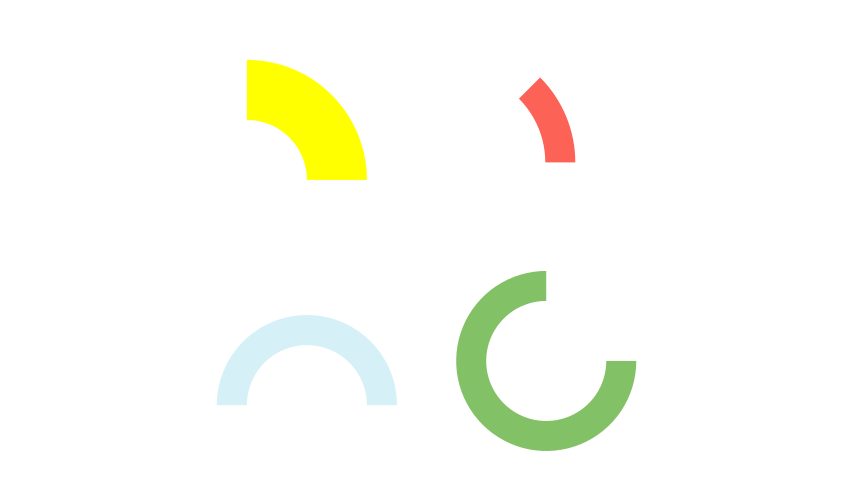AnnularSector#
Qualified name: manim.mobject.geometry.arc.AnnularSector
- class AnnularSector(inner_radius=1, outer_radius=2, angle=1.5707963267948966, start_angle=0, fill_opacity=1, stroke_width=0, color=ManimColor('#FFFFFF'), **kwargs)[source]#
Bases:
ArcA sector of an annulus.
- Parameters:
inner_radius (float) – The inside radius of the Annular Sector.
outer_radius (float) – The outside radius of the Annular Sector.
angle (float) – The clockwise angle of the Annular Sector.
start_angle (float) – The starting clockwise angle of the Annular Sector.
fill_opacity (float) – The opacity of the color filled in the Annular Sector.
stroke_width (float) – The stroke width of the Annular Sector.
color (ParsableManimColor) – The color filled into the Annular Sector.
Examples
Example: AnnularSectorExample ¶

from manim import * class AnnularSectorExample(Scene): def construct(self): # Changes background color to clearly visualize changes in fill_opacity. self.camera.background_color = WHITE # The default parameter start_angle is 0, so the AnnularSector starts from the +x-axis. s1 = AnnularSector(color=YELLOW).move_to(2 * UL) # Different inner_radius and outer_radius than the default. s2 = AnnularSector(inner_radius=1.5, outer_radius=2, angle=45 * DEGREES, color=RED).move_to(2 * UR) # fill_opacity is typically a number > 0 and <= 1. If fill_opacity=0, the AnnularSector is transparent. s3 = AnnularSector(inner_radius=1, outer_radius=1.5, angle=PI, fill_opacity=0.25, color=BLUE).move_to(2 * DL) # With a negative value for the angle, the AnnularSector is drawn clockwise from the start value. s4 = AnnularSector(inner_radius=1, outer_radius=1.5, angle=-3 * PI / 2, color=GREEN).move_to(2 * DR) self.add(s1, s2, s3, s4)
class AnnularSectorExample(Scene): def construct(self): # Changes background color to clearly visualize changes in fill_opacity. self.camera.background_color = WHITE # The default parameter start_angle is 0, so the AnnularSector starts from the +x-axis. s1 = AnnularSector(color=YELLOW).move_to(2 * UL) # Different inner_radius and outer_radius than the default. s2 = AnnularSector(inner_radius=1.5, outer_radius=2, angle=45 * DEGREES, color=RED).move_to(2 * UR) # fill_opacity is typically a number > 0 and <= 1. If fill_opacity=0, the AnnularSector is transparent. s3 = AnnularSector(inner_radius=1, outer_radius=1.5, angle=PI, fill_opacity=0.25, color=BLUE).move_to(2 * DL) # With a negative value for the angle, the AnnularSector is drawn clockwise from the start value. s4 = AnnularSector(inner_radius=1, outer_radius=1.5, angle=-3 * PI / 2, color=GREEN).move_to(2 * DR) self.add(s1, s2, s3, s4)Methods
Initializes
pointsand therefore the shape.Initializes
pointsand therefore the shape.Attributes
animateUsed to animate the application of any method of
self.animation_overridescolordepthThe depth of the mobject.
fill_colorIf there are multiple colors (for gradient) this returns the first one
heightThe height of the mobject.
n_points_per_curvesheen_factorstroke_colorwidthThe width of the mobject.
- _original__init__(inner_radius=1, outer_radius=2, angle=1.5707963267948966, start_angle=0, fill_opacity=1, stroke_width=0, color=ManimColor('#FFFFFF'), **kwargs)#
Initialize self. See help(type(self)) for accurate signature.
- Parameters:
inner_radius (float) –
outer_radius (float) –
angle (float) –
start_angle (float) –
fill_opacity (float) –
stroke_width (float) –
color (Union[ManimColor, int, str, Tuple[int, int, int], Tuple[float, float, float], Tuple[int, int, int, int], Tuple[float, float, float, float], ndarray[Any, dtype[int64]], ndarray[Any, dtype[float64]]]) –
- Return type:
None
- generate_points()[source]#
Initializes
pointsand therefore the shape.Gets called upon creation. This is an empty method that can be implemented by subclasses.
- Return type:
None
- init_points()#
Initializes
pointsand therefore the shape.Gets called upon creation. This is an empty method that can be implemented by subclasses.
- Return type:
None